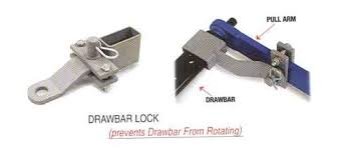Threepoint
Veteran Member
- Joined
- Feb 13, 2014
- Messages
- 2,233
- Location
- No. VA
- Tractor
- Kubota B2150HST w/ LA350 loader, Kubota GF1800 HST, Kioti CK3510SE HST w/ KL4030 loader, Kioti NX4510HST/cab w/ KL6010 loader
I keep a Harbor Freight cat 1 quick hitch on each of my loader tractors. I wanted to use an old "3pt Drawbar" I've had in the barn for years to pull a manure spreader and a log splitter, and to move trailers around, without first removing the QH. A traditional "drawbar lock" (see, e.g. https://qualityfarmsupply.com/product/HITCH-ampersand-LINKAGE/DRAWBARS/873-dash-DB4130) won't work because the QH frame prevents it from locking over the lower lift arm. Without a lock of some sort, there is nothing to prevent the drawbar from rolling over in the QH's lower lift arm hooks.
I've seen other solutions on TBN, but here's mine. It will work on any of the generic QHs, either cat 1 or cat 2, although some of the measurements might need adjustment, and probably on the branded models as well. No welding is involved. I made a pair of DIY drawbar locks from scrap 3/16" steel plate. See pics below. Rather than lock directly to the lower lift arms, they are held in place by the QH's own lower link pins, sandwiching between the hairpin clip and the gussets of QH frame. 3/16" plate is thin enough to do this without modifying or changing out the QH link pins, yet plenty strong as a pair to do the job. NB: That job is only to keep the drawbar from rolling over. Neither they nor the traditional single lock are intended to withstand the inline towing forces on the drawbar. The QH lift hooks (and link arms themselves) are for that. Thus it is important that the rectangular cutouts in the plate be large enough not to interfere with that.
The plate I used is scrap I had on hand. Dimensions for each lock are 9" x 2-3/4" x 3/16". The rectangular cutout is 3" x 1-1/8", cut with a hand-held jig saw with a bimetal blade after drilling starter holes in each corner. I left 3/4" of material between the cutout and the end of the plate. The bend in the plate is made 6-1/8" from the end. The 7/8" hole for the QH link pin is 7" on center from the end. I don't have a brake for my hydraulic press, so I made the bend by just clamping the plate in a vise and persuading it with a 4 lb drilling hammer. That's another reason not to use plate thicker than 3/16". In the pics, you'll also notice two unused 3/8" holes in each adaptor, which were already there in the scrap I used. They don't materially affect the strength of the adaptors.
In the pics, you'll also notice two unused 3/8" holes in each adaptor, which were already there in the scrap I used. They don't materially affect the strength of the adaptors.
If your QH is not a HF hitch, I suggest first cutting a prototype out of stiff cardboard to make sure the measurements don't need adjustment.
In order to keep the drawbar's fixed 7/8" lift pins from slopping around too much in the QH lower hooks, I added bushings cut from 1" galvanized plumbing pipe. They are 1-7/8" long. You can also buy commercial bushings for this, sold as "Cat 2-3" to bush up from 7/8" to 1-1/4".
Finally, and I can't stress this enough. When pulling with a 3pt drawbar, always keep it as low as possible! Pulling with it above the height of the tractor's frame-mounted drawbar dramatically increases the rotational forces around the tractor's center of gravity and risks a turnover.
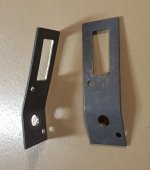

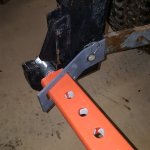
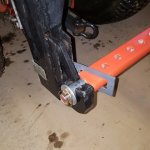
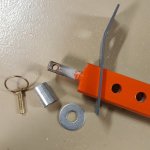
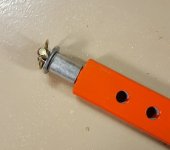
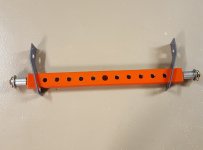
I've seen other solutions on TBN, but here's mine. It will work on any of the generic QHs, either cat 1 or cat 2, although some of the measurements might need adjustment, and probably on the branded models as well. No welding is involved. I made a pair of DIY drawbar locks from scrap 3/16" steel plate. See pics below. Rather than lock directly to the lower lift arms, they are held in place by the QH's own lower link pins, sandwiching between the hairpin clip and the gussets of QH frame. 3/16" plate is thin enough to do this without modifying or changing out the QH link pins, yet plenty strong as a pair to do the job. NB: That job is only to keep the drawbar from rolling over. Neither they nor the traditional single lock are intended to withstand the inline towing forces on the drawbar. The QH lift hooks (and link arms themselves) are for that. Thus it is important that the rectangular cutouts in the plate be large enough not to interfere with that.
The plate I used is scrap I had on hand. Dimensions for each lock are 9" x 2-3/4" x 3/16". The rectangular cutout is 3" x 1-1/8", cut with a hand-held jig saw with a bimetal blade after drilling starter holes in each corner. I left 3/4" of material between the cutout and the end of the plate. The bend in the plate is made 6-1/8" from the end. The 7/8" hole for the QH link pin is 7" on center from the end. I don't have a brake for my hydraulic press, so I made the bend by just clamping the plate in a vise and persuading it with a 4 lb drilling hammer. That's another reason not to use plate thicker than 3/16".
If your QH is not a HF hitch, I suggest first cutting a prototype out of stiff cardboard to make sure the measurements don't need adjustment.
In order to keep the drawbar's fixed 7/8" lift pins from slopping around too much in the QH lower hooks, I added bushings cut from 1" galvanized plumbing pipe. They are 1-7/8" long. You can also buy commercial bushings for this, sold as "Cat 2-3" to bush up from 7/8" to 1-1/4".
Finally, and I can't stress this enough. When pulling with a 3pt drawbar, always keep it as low as possible! Pulling with it above the height of the tractor's frame-mounted drawbar dramatically increases the rotational forces around the tractor's center of gravity and risks a turnover.








